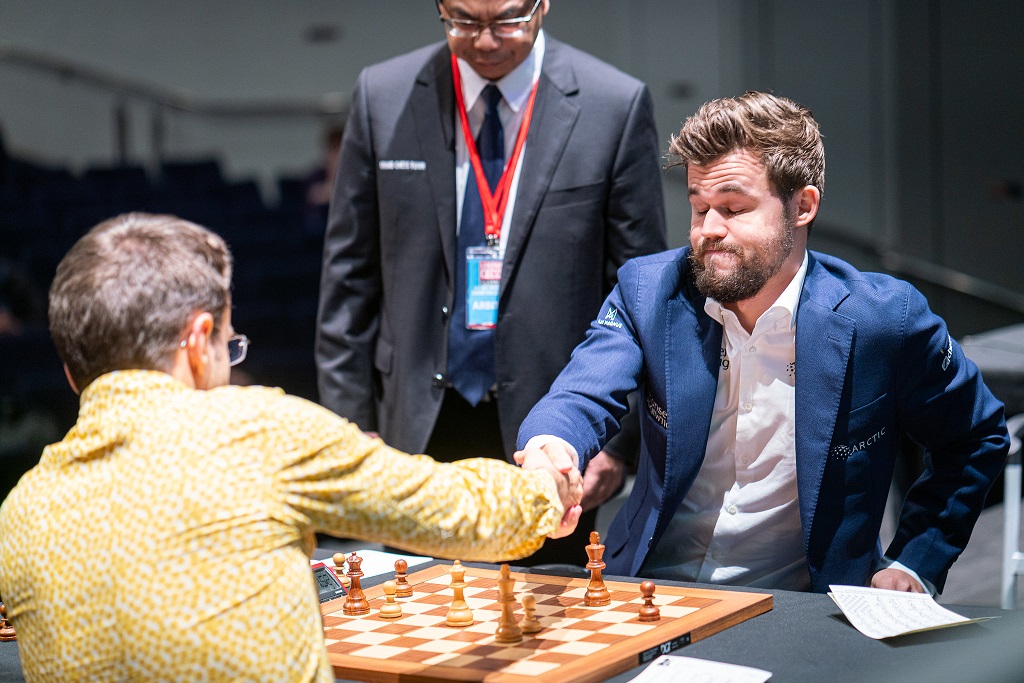


Both matches of the Grand Chess Tour finals reached the rapid and blitz phases with one of the players having a six-point lead. In the fight for first place, Ding Liren scored a fine positional win with the white pieces after having failed to take down Maxime Vachier-Lagrave in game one. In the match for third place, meanwhile, Magnus Carlsen escaped with a draw in the rematch classical encounter against Levon Aronian. Thus, the world champion kept his unbeaten streak — he has not lost a single of his last 107 classical games!
| Final | C1 | C2 | R1 | R2 | B1 | B2 | B3 | B4 | Total |
| Ding Liren | ½ | 1 | 9 | ||||||
| Maxime Vachier-Lagrave | ½ | 0 | 3 |
| 3rd place | C1 | C2 | R1 | R2 | B1 | B2 | B3 | B4 | Total |
| Magnus Carlsen | 1 | ½ | 9 | ||||||
| Levon Aronian | 0 | ½ | 3 |
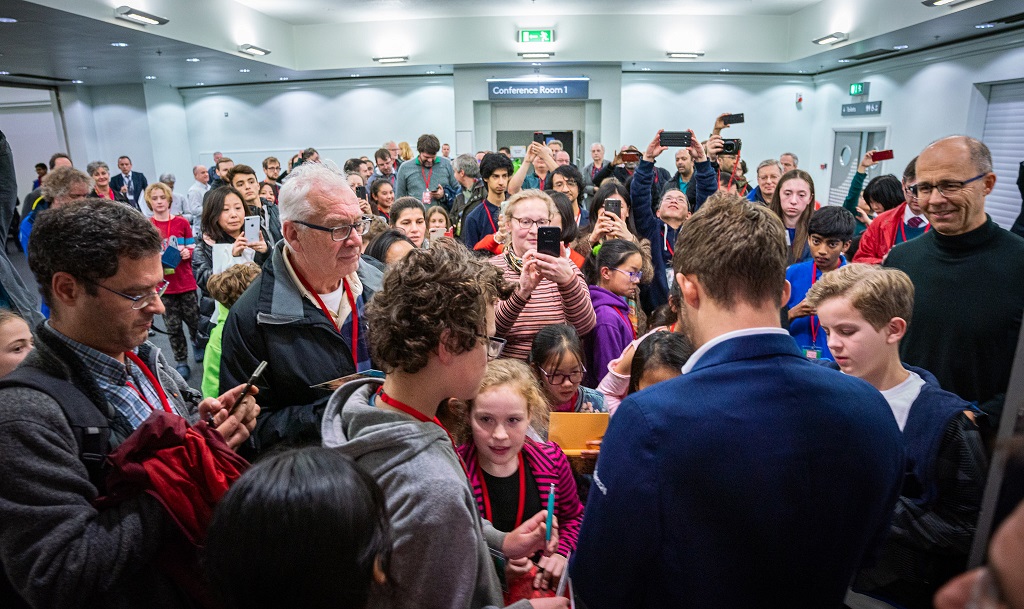
The streak continues, and the fans are still in awe of their hero | Photo: Lennart Ootes / Grand Chess Tour
Ding was excellently prepared to face the opening that ensued in his game against Vachier-Lagrave. He later told Maurice Ashley he had seen the exact position that showed up on the board after 16 moves:
The commentators had judged Vachier-Lagrave's 16...♜fc8 here as questionable, and the Chinese agreed, stating that he had not found a sensible idea for Black in this position. Ding was quite happy with his 17.♘e4 response, and soon gained control over the proceedings.
His positional superiority was so clear that he afforded to manoeuvre his rook back into a defensive position when he considered it necessary:
After doubling his rooks on the a-file, he decided to play 28.♖e1 here, fearing a sacrifice by White on e3.
Ding's handling of his advantage was masterful. Vachier-Lagrave put all his hopes on his passer on the a-file, but when he had pushed his asset all the way down to a2, the Chinese struck with a lethal blow on the kingside:
48.♖xg7 was White's winning shot. Vachier-Lagrave resigned after 48...♚xg7 49.♕g1+ ♚f8 50.♖f5+. Ding confessed afterwards (referring to the rook capture):
I checked it many times. I remembered that yesterday I played too quickly.
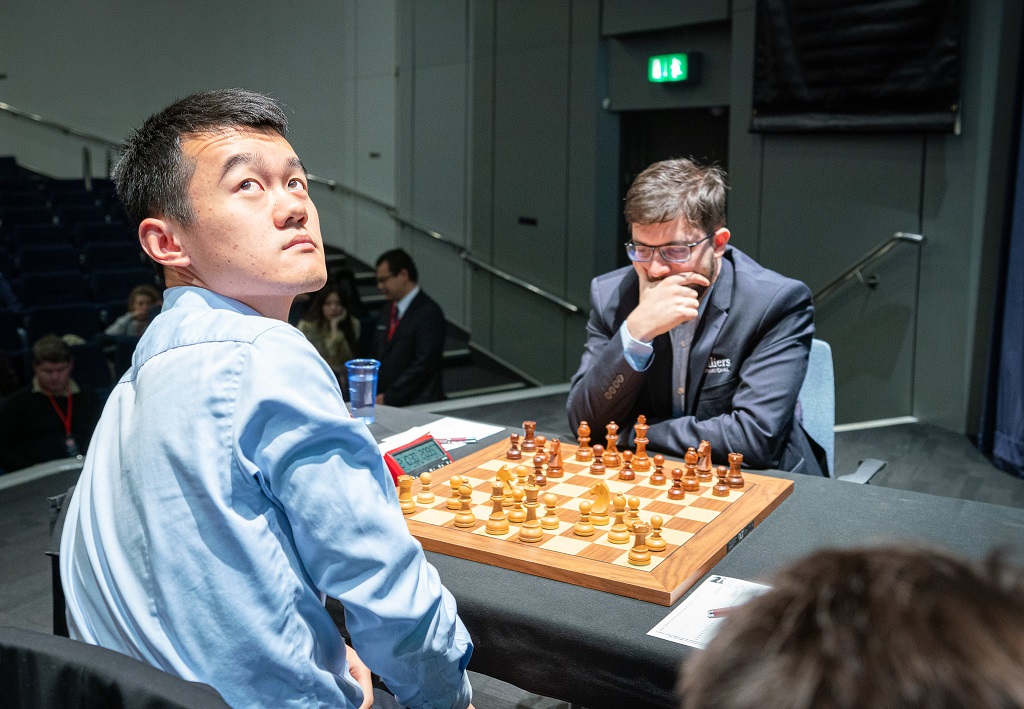
Ding Liren has dominated both games of the final | Photo: Lennart Ootes / Grand Chess Tour
The second classical encounter in the match for third place was a thriller, especially due to the fact that Magnus Carlsen was inches away from losing his astounding 100-plus unbeaten streak in the very last classical game of the year. For Levon Aronian, this would have been a great morale booster after his haphazard play in London, but it was not to be...
Aronian went for a bold approach right out of the gate:
The Armenian went for the throat with 11.h4, to which Carlsen responded in kind with 11...b5. The Norwegian's advance turned out to be overly optimistic, as Aronian slowly but surely got the upper hand. Carlsen felt he had a clearly worse position after 23.♖h3:
The world champion found what engines consider to be one of his best alternatives with 23...d5, giving up a second pawn — 24.exd5 ♝a8 25.♖f3 ♜b8 26.♕c2.
White was clearly in the driver's seat, and Aronian seemed to be en route to a noteworthy victory, but his clock kept ticking down and his rival continued to pose problems in the complex struggle. First, Carlsen bridged the gap with a nice trick on move 35; some five moves later, he faltered, allowing Aronian to recover his edge; and, on move 43, the Armenian used a good-looking trick...that did not quite work in his favour:
Aronian played 43.f7, with the following line in mind: 43...♛xf7 44.♖f4 ♛g6 45.♖xf8+ ♚g7 46.♕d1 ♚xf8 47.♘f4, forking queen and rook. Unfortunately for the Armenian, the queen endgame that arose gave Black chances to hold — Carlsen defended accurately and the draw was signed on move 81. The world champion explained:
43.f7 is a nice trick, but obviously it's unnecessary. Realistically, it just gets me back into the game, which I didn't really deserve.
As usual, the world champion was self-critical and honest while evaluating his play:
First of all, it was — objectively speaking — an awful game quality-wise. I just made so many mistakes, and I think he made a number as well. Obviously I was lost, completely lost, but I hung in there and managed to get this queen ending...
Maurice Ashley, naturally, asked him about his unbeaten streak, and a tired-looking yet contented Carlsen responded:
It's befitting to end the year in classical chess with an escape, since I've had a few of those. And that's what you need to keep the streak going.
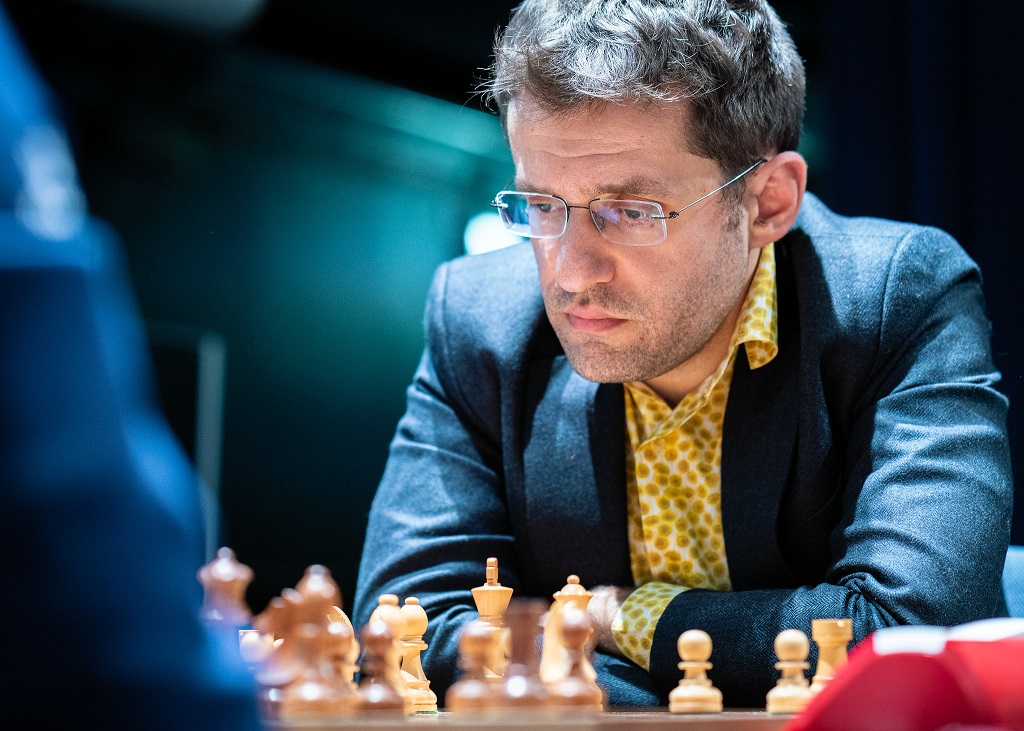
Levon Aronian was inches away from ending Carlsen's amazing streak | Photo: Lennart Ootes / Grand Chess Tour
It has already become a tradition for the London Chess Classic to host the British Knockout Championship alongside the main grandmaster tournament (now part of the GCT) and many other side events. This year's British KO saw the four strongest active players from the Isle reaching the semi-finals — Matthew Sadler is in fact the second highest-rated player from England, but he barely plays of late. In the end, Michael Adams prevailed, as he beat David Howell in the final. Adams had eliminated Luke McShane in the semis, while Howell had knocked out Gawain Jones.
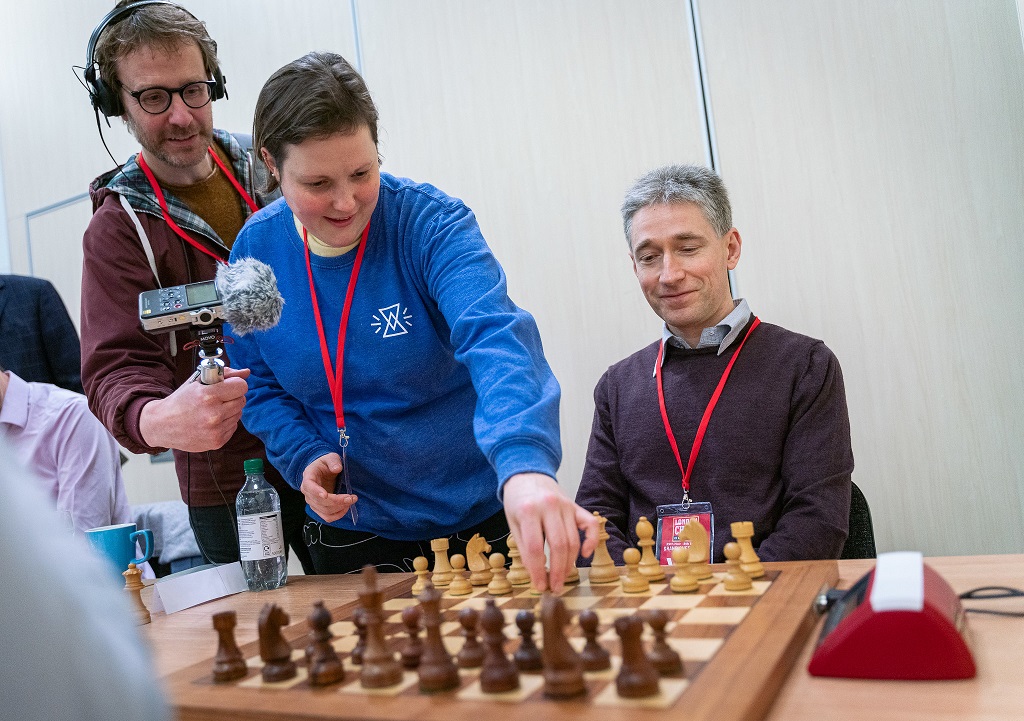
At 48, Mickey Adams is still going strong | Photo: Lennart Ootes / Grand Chess Tour
The semi-finals followed the following format: 2 classical games, followed by 2 rapid and 4 blitz games, followed by 2 blitz playoff games and an Armageddon blitz game if required to decide the winner of each match.
In the midst of the event, the organizers decided to use a different format for the final, with 4 rapid games followed by 6 blitz encounters. After drawing the first two rapid games, Adams scored two consecutive wins. The second of these wins saw the veteran hunting Black's king in the centre:
Howell was already in a difficult situation, but his 21...♛xe4 was a grave mistake, as it allowed 22.♕e7+ ♚c8 23.♖xf7 ♛c6 24.♖f8+ and White has a big edge.
Back in August, Adams also won his seventh British Champion title in Torquay, when he finished a half point ahead of Howell.
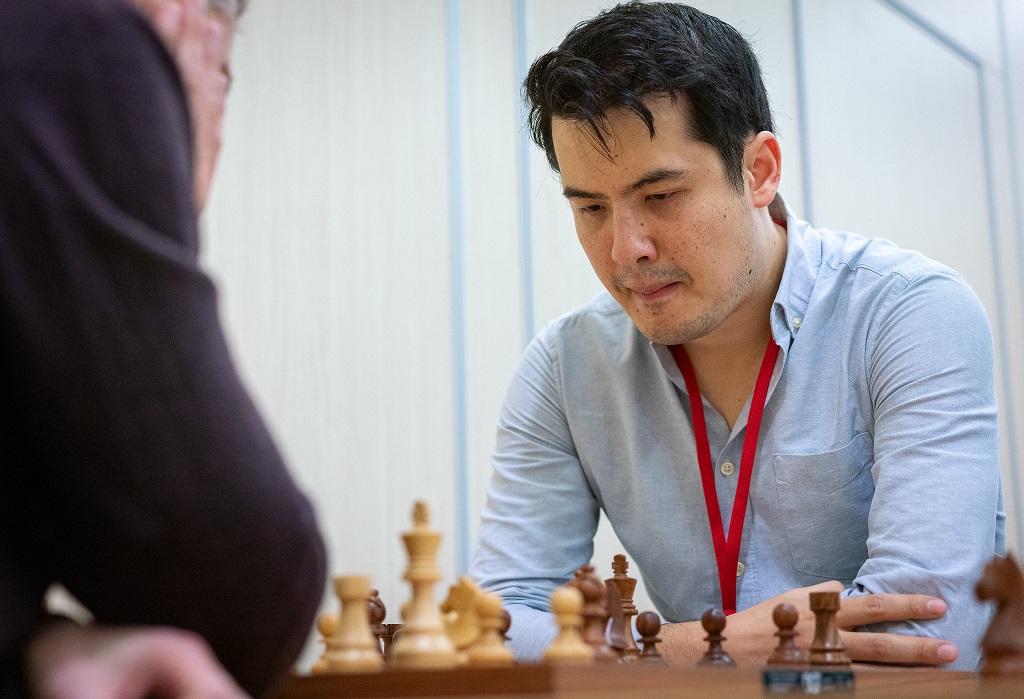
David Howell has been showing great results lately | Photo: Lennart Ootes / Grand Chess Tour
| Semi-final 1 | C1 | C2 | R1 | R2 | B1 | B2 | B3 | B4 | Total |
| David Howell | 1 | ½ | 0 | ½ | 0 | 1 | ½ | ½ | 15 |
| Gawain Jones | 0 | ½ | 1 | ½ | 1 | 0 | ½ | ½ | 13 |
| Semi-final 2 | C1 | C2 | R1 | R2 | B1 | B2 | B3 | B4 | Total |
| Michael Adams | ½ | ½ | 0 | 1 | 1 | ½ | 0 | 1 | 15 |
| Luke McShane | ½ | ½ | 1 | 0 | 0 | ½ | 1 | 0 | 13 |
| Final | R1 | R2 | R3 | R4 | B1 | B2 | B3 | B4 | B5 | B6 | Total |
| Michael Adams | ½ | ½ | 1 | 1 | ½ | 0 | ½ | ½ | 1 | ½ | 18 |
| David Howell | ½ | ½ | 0 | 0 | ½ | 1 | ½ | ½ | 0 | ½ | 10 |
Commentary by Jennifer Shahade, Peter Svidler, Alejandro Ramirez and Maurice Ashley
Times in UTC.
| Date/Time | Event | Round |
|---|---|---|
| December 2, 16:00 | Carlsen vs Vachier-Lagrave Aronian vs Ding |
Semi-final, Game 1 |
| December 3, 16:00 | Vachier-Lagrave vs Carlsen Ding vs Aronian |
Semi-final, Game 2 |
| December 4 | Semi-finals Rapid & Blitz | 3-8 |
| 16:00 | Rapid | Game 1 |
| 17:30 | Rapid | Game 2 |
| 19:00 | Blitz | Game 1 |
| 19:30 | Blitz | Game 2 |
| 20:00 | Blitz | Game 3 |
| 20:30 | Blitz | Game 4 |
| 21:15 | Playoff | (If necessary) |
| December 5 | Pro Biz Cup | |
| December 6, 16:00 | Final | Classical Game 1 |
| December 7, 14:00 | Final | Classical Game 1 |
| December 8 | Final Rapid & Blitz | |
| 14:00 | Rapid | Game 1 |
| 15:30 | Rapid | Game 2 |
| 17:00 | Blitz | Game 1 |
| 17:30 | Blitz | Game 2 |
| 18:00 | Blitz | Game 3 |
| 18:30 | Blitz | Game 4 |
| 19:15 | Playoff | (If necessary) |
Closing ceremony to follow
6 points for a win, 3 points for a draw and 0 points for a loss in the two Classic games
4 points for a win, 2 points for a draw and 0 points for a loss in the two Rapid games
2 points for a win, 1 point for a draw 0 points for a loss in the four blitz games